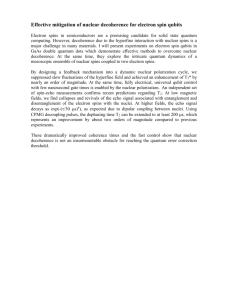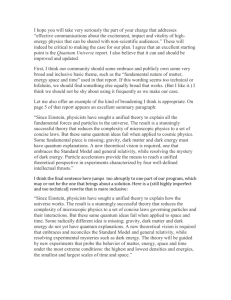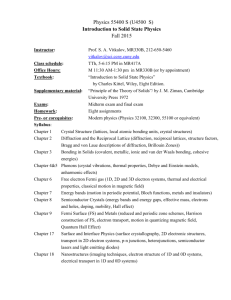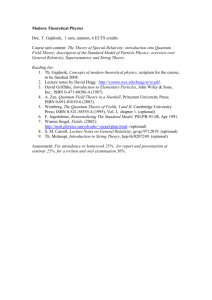Modern Physics
advertisement
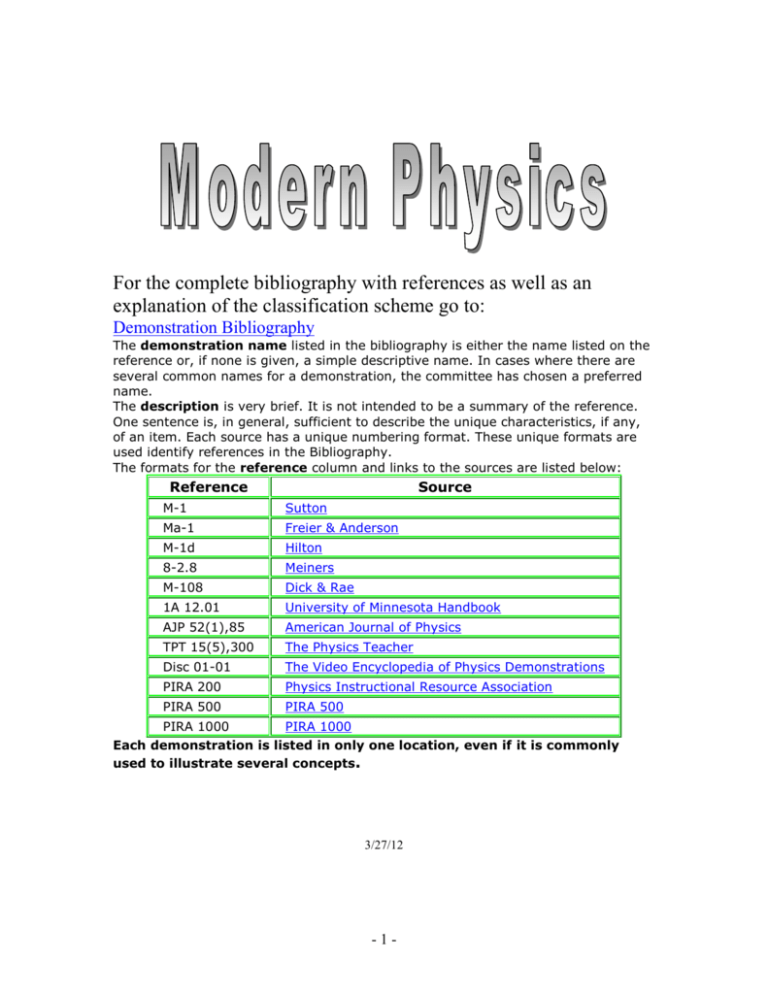
For the complete bibliography with references as well as an explanation of the classification scheme go to: Demonstration Bibliography The demonstration name listed in the bibliography is either the name listed on the reference or, if none is given, a simple descriptive name. In cases where there are several common names for a demonstration, the committee has chosen a preferred name. The description is very brief. It is not intended to be a summary of the reference. One sentence is, in general, sufficient to describe the unique characteristics, if any, of an item. Each source has a unique numbering format. These unique formats are used identify references in the Bibliography. The formats for the reference column and links to the sources are listed below: Reference Source M-1 Sutton Ma-1 Freier & Anderson M-1d Hilton 8-2.8 Meiners M-108 Dick & Rae 1A 12.01 University of Minnesota Handbook AJP 52(1),85 American Journal of Physics TPT 15(5),300 The Physics Teacher Disc 01-01 The Video Encyclopedia of Physics Demonstrations PIRA 200 Physics Instructional Resource Association PIRA 500 PIRA 500 PIRA 1000 PIRA 1000 Each demonstration is listed in only one location, even if it is commonly used to illustrate several concepts. 3/27/12 -1- ...................... 1 KINETIC THEORY ........................................................................................................... 4 Brownian Motion ............................................................................................................ 4 Brownian Motion Cell ................................................................................................ 4 QUANTUM EFFECTS ...................................................................................................... 5 Photoelectric Effect ......................................................................................................... 5 Discharging Zinc Plate ................................................................................................ 5 Stopping Potential ....................................................................................................... 6 Millikan Oil Drop ........................................................................................................... 7 Millikan Oil Drop Experiment .................................................................................... 7 Wave Mechanics ............................................................................................................. 8 Frustrated Total Internal Reflection ............................................................................ 8 Vibrating Circular Wire .............................................................................................. 9 X-ray and Electron Diffraction ..................................................................................... 10 Electron Diffraction .................................................................................................. 10 Microwave Bragg Diffraction ................................................................................... 11 Sample X-Ray Tube .................................................................................................. 12 Condensed Matter ......................................................................................................... 13 Quantum Levitation and Flux Pinning...................................................................... 13 Electron Conduction Model ...................................................................................... 14 Blackbodies ................................................................................................................... 15 Hole in a Box ............................................................................................................ 15 Black Body Spectrum ............................................................................................... 16 ATOMIC PHYSICS ......................................................................................................... 17 Spectra........................................................................................................................... 17 Student Gratings and Line Sources ........................................................................... 17 Absorption..................................................................................................................... 18 Band Absorption Spectrum ....................................................................................... 18 Resonance Radiation ..................................................................................................... 19 Projected Mercury Spectrum .................................................................................... 19 Fluorescence and Phosphorescence .......................................................................... 20 Particle in a Box ........................................................................................................ 21 Ionization Potentials...................................................................................................... 22 Plasma Globe ............................................................................................................ 22 Atomic Models.............................................................................................................. 23 Electron Orbital Models ............................................................................................ 23 NUCLEAR PHYSICS ...................................................................................................... 24 Radioactivity ................................................................................................................. 24 Geiger Counter and Samples .................................................................................... 24 Half Life with Isotope Generator .............................................................................. 25 Half Life of Silver ..................................................................................................... 26 -2- Cosmic Rays ............................................................................................................. 27 Discharge an Electroscope ........................................................................................ 28 Nuclear Reactions ......................................................................................................... 29 Mousetrap Chain Reaction ........................................................................................ 29 Particle Detectors .......................................................................................................... 30 Ludlum Detectors...................................................................................................... 30 Deflection of Beta Rays ............................................................................................ 31 Diffusion Cloud Chamber ......................................................................................... 32 Models of the Nucleus .................................................................................................. 33 Rutherford Scattering ................................................................................................ 33 Rutherford Scattering on an Air Table...................................................................... 34 Rutherford Model...................................................................................................... 35 RELATIVITY ................................................................................................................... 36 Special Relativity .......................................................................................................... 36 Induction Coil Relativity........................................................................................... 36 Lorentz Transformation / Time Dilation................................................................... 37 -3- THERMODYNAMICS 4D10.10 KINETIC THEORY Brownian Motion Brownian Motion Cell Observe the motion of particles in a smoke cell through a microscope. The balls are about 1 micron in diameter. Put a drop of the solution on a slide then place a cover slide on top of it. Use a drop of oil with the oil immersion objective. The well slide works best (less systematic movement); if you use it, place a drop in the well then dilute it with water. Location: Ga3 -4- MODERN PHYSICS 7A10.10 QUANTUM EFFECTS Photoelectric Effect Discharging Zinc Plate A polished (with fine abrasive paper) zinc plate sits atop an electroscope. Charge the electroscope with a rod. Turn on the UV light. Expose the zinc plate to the UV rays. Do not turn the UV light towards the students. Compare what happens when you charge the plate positively with what happens when you charge it negatively. Location: Ka2, Gc2 -5- MODERN PHYSICS 7A10.30 Photoelectric Effect QUANTUM EFFECTS Stopping Potential h/e apparatus. Measure the stopping potential of the lines of the mercury spectrum with a photodiode. Location: Ka2 -6- MODERN PHYSICS 7A15.10 QUANTUM EFFECTS Millikan Oil Drop Millikan Oil Drop Experiment The oil drop experiment. Location: Ka3 -7- MODERN PHYSICS 7A50.10 QUANTUM EFFECTS Wave Mechanics Frustrated Total Internal Reflection Squeeze two right angle prisms together using a C Clamp and some notched blocks of wood while directing a beam of light at the interface. Use the blackboard optics equipment for this. Location: Blackboard Optics Cart -8- MODERN PHYSICS 7A50.40 Wave Mechanics QUANTUM EFFECTS Vibrating Circular Wire The PASCO signal generator drives the PASCO mechanical vibrator. The three node resonance is at 20Hz. Turn up the amplitude after finding the resonance. Other resonances are at 60, 100, and 140 Hz. Pin the wire at 180 degrees from the mechanical vibrator to get full numbers of waves. Location: Ka3, Ec2, Fb4 -9- MODERN PHYSICS 7A60.10 QUANTUM EFFECTS X-ray and Electron Diffraction Electron Diffraction Rings or spots diffraction patterns can be shown to the class using a TV camera. The beam and bias will already be adjusted. Turn up the HV until the pattern appears. Do not let the current exceed 170 microamps. Turn down the HV when you are done. The small jack at the back has a negative bias (20 V or so) on it. The filament voltage is 6.3 V and one side is connected to the common ground for the HV and negative bias supply. Location: Ka4 - 10 - MODERN PHYSICS 7A60.50 X-ray and Electron Diffraction QUANTUM EFFECTS Microwave Bragg Diffraction Microwave diffraction is observed from a crystal model made of steel ball bearings mounted in a Styrofoam cube. Location: Ia7, Ka5 - 11 - MODERN PHYSICS 7A60.95 X-ray and Electron Diffraction Sample X-Ray Tube Show a large X-ray tube. Location: Kd1 - 12 - QUANTUM EFFECTS MODERN PHYSICS 7A70.20 QUANTUM EFFECTS Condensed Matter Quantum Levitation and Flux Pinning A thin film superconductor levitates over a magnet pinned in place by flux quanta. Location: Ga5 - 13 - MODERN PHYSICS 7A70.40 Condensed Matter QUANTUM EFFECTS Electron Conduction Model The Air Cushion Table is used to show bound charge carriers in an insulator; a free charge in an insulator, conduction in a semiconductor (N type and P type. Air Cushion Table manual: 2.4.9, 2.4.10, 2.4.11, 2.4.12, 2.4.13. Location: Ga5 - 14 - OPTICS 6B40.20 PHOTOMETRY Blackbodies Hole in a Box A box that is painted black has a hole in a hinged door. The hole appears blacker than the box, When the door is opened, you see the box is actually painted white on its inside surfaces. Use an infrared camera to look at a hole in a heated aluminum block (100 C). Location: Jb2, Fc5, FLIR Cabinet - 15 - OPTICS 6B40.40 Blackbodies PHOTOMETRY Black Body Spectrum A spectrometer and bolometer connected to Science Workshop is used to record the spectrum from an incandescent bulb at various temperatures. Location: Science Workshop Cabinet, Optics Table Cabinet - 16 - MODERN PHYSICS 7B10.10 ATOMIC PHYSICS Spectra Student Gratings and Line Sources Pass out the 1"x1" gratings to the students. These have 13,400 lines per inch. Turn on one of the light sources. There is a single filament white light source and three discharge tubes, Hg, He, and Ne. The Didymium filter can be placed in front of the white light source to show selective absorption. Also shown is a spectrometer with a TV camera showing hydrogen Balmer lines and the Ride Tide USB spectrometer showing the line spectrum on the computer. Use the door lite curtains to darken the room. Location: Ja1, Jb2 - 17 - OPTICS 7B11.65 ATOMIC PHYSICS Absorption Band Absorption Spectrum Didymium glass is used to show band absorption. The Reveal 60 bulb is used with both a grating and the Red Tide spectrometer to show the bands. An ordinary bulb is shown for comparison. Location: Jb2, Ib1 - 18 - MODERN PHYSICS 7B13.42 ATOMIC PHYSICS Resonance Radiation Projected Mercury Spectrum The UV lines of the projected spectrum are made visible using a fluorescent board Location: Ka2 - 19 - MODERN PHYSICS 7B13.50 Resonance Radiation ATOMIC PHYSICS Fluorescence and Phosphorescence Fluorescent and phosphorescent materials are shown with a black light. Location: Kb3 - 20 - MODERN PHYSICS 7B13.51 Resonance Radiation ATOMIC PHYSICS Particle in a Box Nanobeads (quantum dots) of 4 different sizes in solution fluoresce when illuminated with a UV light. The energy calculation is based on the calculation of a particle in a potential sphere (see the appendix of the instructions for more info). The quantum "sphere" or "box" is not empty but filled with a semiconductor. In order for the students to understand this they must first start with the derivation of a 1D particle in a box calculation, the sphere is basically the same physical concept with a different mathematical geometry. Using the Red Tide spectrometer the peaks from the different fluorescing vials can be measured and compared with theory. Location: Kb3 - 21 - MODERN PHYSICS 7B35.75 ATOMIC PHYSICS Ionization Potentials Plasma Globe Commercial plasma tubes are discussed. Bring your hand near the globe. Location: Kb4 - 22 - MODERN PHYSICS 7B50.10 ATOMIC PHYSICS Atomic Models Electron Orbital Models A set of Klinger electron orbital models. Location: Kb5 - 23 - MODERN PHYSICS 7D10.10 NUCLEAR PHYSICS Radioactivity Geiger Counter and Samples Turn on the counter and place sample under Geiger Tube. Test to see how distance from the sample affects the count. Place objects like: paper, wood, lead and other items between the source and the tube to check their shielding properties. The alpha paddle can be used to selectively detect alpha particles only. Location: Kb6 - 24 - MODERN PHYSICS 7D10.20 NUCLEAR PHYSICS Radioactivity Half Life with Isotope Generator Follow the instructions on how to “milk” the generator. It is good practice to survey the work area before and after for contamination. The Geiger counter can be connected to the computer and using Science Workshop one can plot the count rate as a function of time. Location: Kb6 - 25 - MODERN PHYSICS 7D10.33 NUCLEAR PHYSICS Radioactivity Half Life of Silver Measure the half life of silver activated by a neutron source. Use a glove to handle the “hot” silver as it is a beta emitter. Leave as the closest position to the neutron source for a few minutes to activate it. Location: Advanced Lab, Kb6 - 26 - MODERN PHYSICS 7D10.80 Radioactivity NUCLEAR PHYSICS Cosmic Rays Scintillator detectors show the passage of a cosmic ray by coincidence counting. - 27 - Electricity and Magnetism 5D40.30 Conduction in Gases RESISTANCE Discharge an Electroscope Charge the electroscope either positively or negatively by induction. Then place the Po-210 source (0.5 mCi when new) in the electroscope and watch the electroscope discharge in a couple of seconds. Use safety protocols when handling the source. Location: Kb6, Gc2 - 28 - MODERN PHYSICS 7D20.10 NUCLEAR PHYSICS Nuclear Reactions Mousetrap Chain Reaction A 72 mousetraps with corks set on them. Trigger with a single “neutron” (cork). This requires about 20 minutes and nerves of steel to set up. Each trap stores about a joule of energy when set. Location: KbT - 29 - MODERN PHYSICS 7D30.05 NUCLEAR PHYSICS Particle Detectors Ludlum Detectors Ludlum hand held alpha, beta and gamma detectors are used with a variety of sources. Location: Kb6 - 30 - MODERN PHYSICS 7D30.30 NUCLEAR PHYSICS Particle Detectors Deflection of Beta Rays Turn on the counter and lay it on its side. Open the beta window. Place a beta source nearby, being sure the emitting side is toward the counter. Then bring a strong magnet near the source. The count rate will drop. Location: Kb6, Hd5 - 31 - MODERN PHYSICS 7D30.60 NUCLEAR PHYSICS Particle Detectors Diffusion Cloud Chamber This demo requires advance notice to obtain ice and let the chamber cool (about 40 minutes). Tracks are most impressive if the students are allowed to view individually. The TV works quite well too. Use either ambient cosmic rays or Pb 210 as a source. Location: Kc1 - 32 - MODERN PHYSICS 7D50.10 NUCLEAR PHYSICS Models of the Nucleus Rutherford Scattering Balls roll down a ramp onto a potential surface to model Rutherford scattering. Location: Kc2 - 33 - MODERN PHYSICS 7D50.14 NUCLEAR PHYSICS Models of the Nucleus Rutherford Scattering on an Air Table The Air Cushion Table is set up with a plastic platform that holds a magnet which repels a magnetic puck that is set in motion beneath it (Air Cushion Manual, 2.5.1). One can also illustrate the scattering of alpha particles through a foil using a foil made of a 1D lattice four magnets that repel a magnetic puck that is set in motion toward it (Air Cushion Table Manual 2.5.2. Location: Ga4 - 34 - MODERN PHYSICS 7D50.25 NUCLEAR PHYSICS Models of the Nucleus Rutherford Model The Air Cushion Table is set up with a plastic platform that holds a magnet which attracts a magnetic puck that is set in motion beneath it (Air Cushion Manual, 2.5.3). The moving puck goes into orbit beneath the attracting magnet. Location: Ga4 - 35 - MODERN PHYSICS 7F10.35 RELATIVITY Special Relativity Induction Coil Relativity On using the simple induction coil and galvanometer as a special relativity demonstration: AJP 48(9), 780. Location: BdT, Hc2, Ib3 - 36 - MODERN PHYSICS 7F10.60 RELATIVITY Special Relativity Lorentz Transformation / Time Dilation The Mechanical Universe, chapter 42, and the Hewitt film "Relativistic Time Dilation" Location: Ad5 - 37 -



